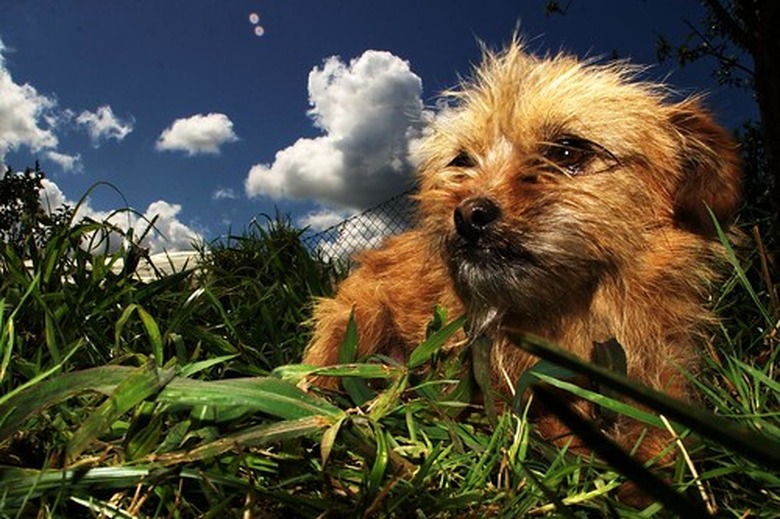Cedar Mulch & Dogs
Cedar mulch is a favorite of many gardeners because of its aromatic fragrance, minor insect repelling qualities and relative durability. Like other mulches, cedar mulch may be attractive to dogs for many reasons: for use as an outdoor "litterbox" area, for chewing on, rolling in or digging in. Academic research is limited in its findings on the specific dangers or benefits of cedar mulches to dogs.
About Cedar Mulch
Cedar mulches come in several color and grade varieties. Natural, undyed cedar mulch comes in white, red and brown, and in grades ranging from finely shredded to coarse. Finely shredded cedar mulches, like other mulches, break down relatively rapidly in the garden, while coarse cedar mulches consist of thicker chunks that stay intact over several seasons.
Potential Problems
The main problem with using cedar mulch in a yard where a dog has access is with chewing or digging. Garden experts recommend using a finely shredded mulch in yards where wood-chewing dogs live; a chunkier cedar mulch may only invite more chewing. Cedar mulch isn't toxic to dogs, but dogs which ingest too much mulch may vomit or have diarrhea afterward. Extreme cases may involve lodged splinters or blockages created by eating too much wood.
- Cedar mulch is a favorite of many gardeners because of its aromatic fragrance, minor insect repelling qualities and relative durability.
- Like other mulches, cedar mulch may be attractive to dogs for many reasons: for use as an outdoor "litterbox" area, for chewing on, rolling in or digging in.
A thick-cut cedar mulch might also attract a dog for use as a "doggie litter box." Cedar mulch with large pieces is quite loose and may be an irresistible digging target.
Solutions
Apart from rigorous behavior training, a dog's owner has limited options to prevent their pet from excavating the garden beds. Spraying a mulched bed with garlic water or bitter apple spray might help deter digging behaviors. If the dog is a chronic digger, one extreme yet effective measure is to put down chicken wire or other metal mesh at the soil level of the garden bed, beneath the mulch.
Potential Benefits
The main benefit of using cedar mulches around plantings in the yard is for cedar's reputation as an insect repellent. Cedar is promoted as an ant repellent because of its main volatile oil compound, plicatic acid. Plicatic acid has been shown to have limited flea repellent benefits, as well. But this advantage is short-lived: the aromatic oils in cedar break down quickly in a landscape setting, and if mice and other yard pests bring in fleas, cedar won't be much help after a couple of months.
- A thick-cut cedar mulch might also attract a dog for use as a "doggie litter box." The main benefit of using cedar mulches around plantings in the yard is for cedar's reputation as an insect repellent.
At best, cedar mulch is a nice-smelling, attractive option with few obvious benefits for dogs. On the flip side, cedar mulch presents few dangers, unless your dog is prone to habitual chewing of wood chunks.
Other Mulch Warnings
Veterinarians and gardeners alike recommend that dog owners never use cocoa hull mulch in yards where dogs have access. Cocoa mulches contain theobromine, the compound which makes chocolate poisonous for dogs. The smell and taste of cocoa mulches are highly attractive to dogs, and eaten in sufficient quantities a dog can get "chocolate sickness." Symptoms include vomiting, spasms, increased heart rate, seizures and death; smaller dogs are affected more readily than large breeds.
